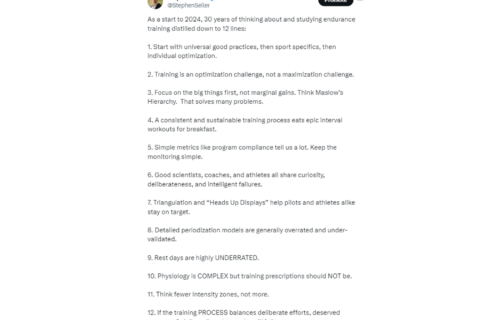Siren Seiler talks about getting back into running and the importance of building good habits around training and recovery.
Video Transcript
Siren Seiler 0:02
During the beginning, after surgery, I found that to be a very, very good way to start training kind of the central system without the big mechanical loading on your legs and…
Dr. Stephen Seiler 0:17
Just walking uphill.
Siren Seiler 0:19
Yeah, walking uphill.
Dr. Stephen Seiler 0:20
Or on the treadmill or, yeah.
Siren Seiler 0:21
And you do get, for sure get the heart rate up when you have a certain incline. But then after a while, maybe doing 5-minute walk, 5-minute jog, 5-minute walk, 5-minute jog for maybe like 20 minutes to 25 minutes and then extending to 30 minutes. And then when that kind of becomes easier, then you increase the length of the run period, so maybe you have 10 minutes run, 5 minutes walk, 10 minutes run. And kind of just building up or on top of this, like, each week; increasing the run duration and shortening the walking duration so that you feel like you can run continuously. Which I think is maybe the first step you have to—you have to be able to kind of run nonstop, which for many people, they can’t run more than 15 minutes at a time without having to stop. Like, for me as well, when I started running back after surgery, I had to really take small baby steps. Like, I couldn’t think of myself as, who did 20K runs, like, easy. And without feeling it in my legs, like, then I was really feeling it after 30 minutes. So it was kind of a whole new experience for me.
And it was very weird to experience because you think you have like a body who—that kind of tolerates everything. And then you have to really take a step back and just realize, okay, that’s not the case right now. But it’s with everything. When you stop doing something, you will get worse at it, and you have to kind of build back up again. And so from my own experience, and from the experience with my athletes, I realized that it’s—you have to really start, like, take baby steps and not try to bite over too much too soon, because then you’ll really get a bad experience. And it’s the—you have to build on top of good experiences. Because the mental side of it definitely plays a big role in developing your athletic skills or your physical ability as well. So you have to build on successes.
Dr. Stephen Seiler 3:12
If we think about, you know, the mom that you’re working with, or the grandma that—in some ways, it’s easier to help them because they don’t have the prior expectations. But it’s tough to be the former athlete or the injured athlete or the operated athlete that is has a certain mental image of, “This is me, and it’s not matching up.” And so then there’s this disconnect between what they’ve been and what they are. And I think that’s a challenge to just recalibrate.
And I’ve talked with coaches that have worked with severely overtrained athletes, and they say that the first step is to get them to recalibrate and, say, not compare themselves with their best version, but compare themselves with where they were yesterday. And then you can start to see the improvements and clap yourself on the shoulder and move forward. And I think that’s still true. You know, it’s just these small baby steps, like you talked about, is giving your client or your athlete permission to be happy with those small improvements. Is that reasonable?
Siren Seiler 4:32
Yes. For sure. And I have to be fully honest, like, even today, like, I struggled the whole time. Like for seven months or more, like. And still I’m not back to the level where I was. So—but getting closer.
And it’s just to say that it’s not supposed to be easy. And it’s not like you’re suddenly doing all the right things mentally and like, “Oh, now I accept where I am.” Like, it’s hard and I was doing—I was really not good at it because I got angry and frustrated and I didn’t want to train. Because it wasn’t fun anymore, because I wasn’t running easy and fast and light and kind of, it was hard. And I was breathing heavy and I felt heavy in my step. So I wasn’t enjoying running as I used to do. And that itself is very hard to feel like. And I think that also in every sport, like, you’re supposed to enjoy it. And it can be hard to find that area or what you, why you do it. Like, but for me, what I had to start thinking was, “Okay, I do enjoy the process. And I do kind of like to see these improvements.” And not think too much about the time itself.
But for pace, or watts for cyclists, but rather, like, think of the process and doing the process very well. And as we talked about last time, the recovery part of it and kind of getting better at the things I wasn’t so good at, which was my focus this year. And but for other athletes who doesn’t have the former experience, it’s also just about getting a habit going because in the beginning, you won’t feel that endorphin kick or kind of the good feelings that we who do it, like, very regularly, and you kind of get this runner’s high or the, I don’t know, cyclists high [laughs].
Dr. Stephen Seiler 7:02
Yeah.
Siren Seiler 7:04
Many—or the people who kind of start training, they don’t get this, which I’ve learned through my athletes. You don’t—it feels heavy, and you kind of have to make yourself do it. But then through or over time, it gets easier. And then suddenly, they want to go out the door, and then suddenly they do get the feedback from the body like, that it craves the training, which it never used to do. And the same I experienced myself. Like, I didn’t get the same feedback from my buddy in the start of like, maybe two months or something.
And that is when—that’s the hard part of training: It’s very easy to train when you’re in good shape, but it’s very hard when you are not and you don’t know exactly where you’re going. But if you really like it and have a good support system and, like, people who believe in you and you know that it’s for a good—even for health, or for performance goals, or for your kids, or whatever—like, it’s definitely worth it and you will get that good response after a while. But it’s all about, like, habits or habit building, I think.



